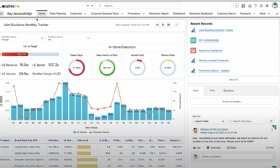
Salesforce expands consumer packaged goods cloud
Salesforce to add features next year that help consumer goods manufacturers plan, track and analyze effectiveness of promotional spending with retailers.
Salesforce added features to its Consumer Goods Cloud that enable consumer packaged goods manufacturers to track and analyze what they spend on "trade promotions" with the stores that carry their products. The features will be available in the first half of 2022.
New capabilities in Consumer Goods Cloud include Trade Promotion Analytics, which measures and predicts effectiveness of trade spending in conjunction with consumer marketing spending. Key Account and Promotion Planning enables consumer package goods (CPG) companies to manage business plans and budgets on the account level.
Promotional agreements between retailers and consumer packaged goods companies require store check-ins and confirmation that a retailer is holding up its end of the bargain. A "mobile offline retail execution" app enables CPG company field reps to complete store visit activities -- such as confirming shelf placements and other obligations written into promotional contracts -- even if they've lost a connection.
It was a needed feature, because cell signals typically degrade in the back of many stores, said Sunil Rao, vice president and general manager for consumer goods at Salesforce. The previous edition of the app required a pervasive connection.
The new features for Salesforce Consumer Goods Cloud came from intellectual property acquired from Accenture that was originally built on the Force.com platform, Rao said. Large companies such as Budweiser beer parent company AB InBev and Unilever use Consumer Goods Cloud, as well as other CPG companies that have $100 million or more in annual sales, he added.
In total, there are 12 Salesforce vertical-specific clouds. The Salesforce Consumer Goods Cloud was one of several vertical-industry-specific clouds launched before Salesforce acquired Vlocity last year, an acquisition that gave immediate rise to several new clouds for media, telecommunications, government and utilities.

Because Salesforce doesn't have an ERP cloud, it is behind competitors such as SAP, Oracle and Microsoft, which also have features and capabilities for CPG companies to manage their promotional spending among retailers and merchandiser middlemen, said Kate Leggett, an analyst at Forrester Research. She characterized Salesforce Consumer Goods Cloud as "lightweight" in comparison to those competitors.
"The reason SAP and Oracle do so well is because you've got all the back-end order management and supply chain management products," Leggett said. "You need visibility into your supply chain for your orders to be able to do real retail execution."
However, things are changing in consumer packaged goods as companies struggle to connect marketing data to sales and supply chains to quantify return on marketing investments. Complicating matters are large retailers such as Amazon, Walgreens and Walmart, which have set up their own advertising networks that combine website, mobile app and physical in-store promotions.
These networks appeal to manufacturers because the retailers own their data, and third-party data is becoming less reliable by the day due to consumer privacy protections laws and the deprecation of the third-party cookie.
Trade promotion is typically considered B2B spending, and advertising and marketing B2C spending, Rao said. Salesforce believes it can gain an edge with its plans to increase integrations between Consumer Goods Cloud and Marketing Cloud and help its users monitor both kinds of budget -- and returns on investment -- within its platform.
"For the planners on the B2B side, what elements of the B2C plans can be brought in when they're having joint business planning discussions with retailers?" Rao said. "These are the processes that we think we can start unlocking."
Don Fluckinger covers enterprise content management, CRM, marketing automation, e-commerce, customer service and enabling technologies for TechTarget.








